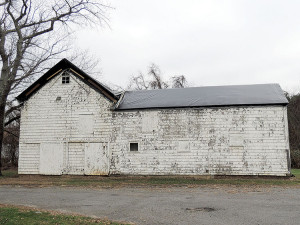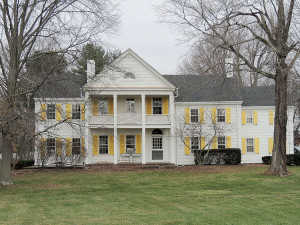Story and Photos by Laura D.C. Kolnoski
Lisa Laird Dunn is still making history – and America’s oldest blended Applejack. The ninth generation steward of Laird’s Distillery is turning an aging barn on the 22-acre property into a museum and visitor’s center to celebrate her family’s unique 300-year-old legacy.
Laird Dunn, the firm’s executive vice president, hopes to open the museum in 2017. With her father Larrie Laird, company president and CEO, and other family members, an extensive renovation of their familiar white and yellow offices nears completion. The museum would allow the family to centralize and display its many historic artifacts, documents, photos and other items collected and preserved over the decades.
In 1933, Laird’s Distillery, the oldest family of distillers in the country, was granted Federal Liquor License #1 under the Prohibition Act to distill apple brandy for medicinal purposes. The company was begun by William Laird, who came to America from Scotland circa 1698, bringing his ancestors’ apple brandy recipe with him. He set up shop at what is now the Colts Neck Inn on Route 537, then known as the Burlington Path, a main road traveled by local American Indians and colonists, including Gen. George Washington. Washington so enjoyed the “cyder spirits” he requested the recipe and remains the only family outsider to have obtained it. The Lairds operated the inn, tavern and distillery, while Robert Laird joined Washington’s forces during the American Revolution, and supplied fellow troops with his family products.

After the distillery at the inn was destroyed by fire in 1849, a fifth generation Laird rebuilt it a few miles east on Route 537 in its present location. Lisa Laird Dunn was the last descendant to reside in the family home there before it was converted into offices. The property includes a 155,000 square-foot bottling facility/warehouse, a barrel warehouse and smaller structures including the white barn slated for the museum.
In addition to hosting business guests, Laird Dunn envisions holding public tastings and presentations. Among the heirlooms that will grace the space are antique jugs and early Applejack bottles, the family tree, timelines, old barrels, historic photos of the distillery and its owners through the generations and depictions of Laird’s famous customers, including American presidents.
Abraham Lincoln served Applejack in his Illinois tavern for 12 cents a half-pint. William Henry Harrison, campaigning in 1840, became known as the “Hard Cider Candidate.” During Prohibition, a drink made with hard cider and Applejack called the “Stonewall Jackson” was in vogue, as was the “Jack Rose.” President Lyndon Johnson presented a case of Applejack to Soviet Premier Alexei Kosygin at their 1967 Glassboro summit, and Bill Clinton served a recipe made with it at his first Inaugural Ball. President Barack Obama’s 2009 holiday party featured the classic Colonial drink the “Stone Fence,” made with Applejack, bitters and mint.
Business faltered during “lean years in the ‘70s, ‘80s, and ‘90s when vodka and gin were more popular,” Laird Dunn said.
“We continued to sell the product because it’s the heart and soul of the company,” Laird Dunn said. “With the resurgence of classic cocktails and brown spirits, we can’t produce enough.”

Laird’s recently introduced a new “Jersey Lightning” brand of un-aged, clear straight apple brandy, resurrecting the name from Colonial days. Today, Laird’s labels include Senator’s Club and Banker’s Club bourbon, scotch, vodka, whiskey, gin, rums and brandy, along with imported products. New Jersey laws prevent Laird & Company from selling direct to customers but the firm’s products can be found throughout the state and via their website.
The barn will be largely gutted to create the museum and visitors center. Laird Dunn hopes to retain the stalls and other features, including the original root cellar, which guests could see through plexiglass on the main floor. The second floor would not be accessible to the public, but would be opened with a cutout so visitors could view inside.
“I’m trying to keep the historic, authentic wood exterior,” Laird Dunn said. “The ceiling will be cut out and lit so folks can see what the top of the barn looks like with artifacts. We hope to present much to the public, based on what the town will allow.”
Across Laird Road, Eastmont Orchards, which once supplied apples to Laird’s Distillery, opens to the public in season for fruit picking. Across the township on Hillsdale Road, the picturesque 4JG’s Winery & Vineyards, located on a 1700s farm, began operations in 1999 following a lengthy hearing and approval process.
“Laird’s remains America’s sole producer of blended Applejack, which is a blend of 65 percent neutral grain spirits and 35 percent apple brandy similar to a whiskey,” Laird Dunn said. “Fall through the holidays is Applejack season. Hot cider drinks are a natural and mix so well with brown spirits.”
Among the family’s holiday traditions is quaffing Laird’s Eggnog, the recipe for which can be found in their exclusive cookbook, “Applejack: The Spirit of America,” compiled and edited by Laird Dunn and her mother Rose Marie, and published by the company. The 146-page book includes family history, sketches, vintage photographs, and food and drink recipes featuring Laird products. In addition to family recipes, Martha Washington’s Applejack Walnut Cake is included.
“Not many people have a history like we do,” Laird Dunn said. “My ancestors had no inkling 300 years ago that the company would still be in business today. I realized how important that is as I got older. I love to talk about the history of Laird’s.”














